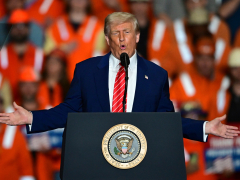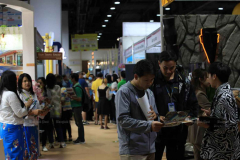United States President Donald Trump has announced his administration is raising tariffs on steel imports from 25 percent to 50 percent.
Speaking to steelworkers and supporters at a rally outside Pittsburgh, Pennsylvania, Trump framed his latest tariff increase as a boon to the domestic manufacturing industry.
“We’re going to bring it from 25 percent to 50 percent, the tariffs on steel into the United States of America, which will even further secure the steel industry in the United States,” Trump told the crowd. “Nobody’s going to get around that.”
How that tariff increase would affect an existing free-trade pact with Canada and Mexico – or a separate trade deal struck earlier this month with the United Kingdom – remains unclear.
Also left ambiguous was the nature of a partnership developping between Nippon Steel, the largest steel producer in Japan, and the domestic company US Steel. Still, at the rally, Trump played up the partnership as a “blockbuster agreement”.
“ There’s never been a $14bn investment in the history of the steel industry in the United States of America,” Trump said of the deal.
A tariff hike on steel
Friday’s rally was a return to the site of many election-season campaign events for Trump and his team.
In 2024, Trump hinged his pitch for re-election on an appeal to working-class voters, including those in the Rust Belt region, a manufacturing hub that has declined in the face of the shifting industry trends and greater overseas competition.
Key swing states like Pennsylvania and Michigan are located in the region, and they leaned Republican on election day, helping to propel Trump to a second term as president.
Trump, in turn, has framed his “America First” agenda as a policy platform designed to bolster the domestic manufacturing industry. Tariffs and other protectionist policies have played a prominent part in that agenda.
In March, for instance, Trump announced an initial slate of 25-percent tariffs on steel and aluminium, causing major trading partners like Canada to respond with retaliatory measures.
The following month, he also imposed a blanket 10-percent tariff on nearly all trade partners as well as higher country-specific import taxes. Those were quickly paused amid economic shockwaves and widespread criticism, while the 10-percent tariff remained in place.
Trump has argued that the tariffs are a vital negotiating tool to encourage greater investment in the US economy.
But economists have warned that attempting a “hard reset” of the global economy – through dramatic tax hikes like tariffs – will likely blow back on US consumers, raising prices.
Rachel Ziemba, a senior fellow at the Center for a New American Security, said the latest tariff hike on steel also signals that negotiating trade deals with Trump may result in “limited benefits”, given the sudden shifts in h





